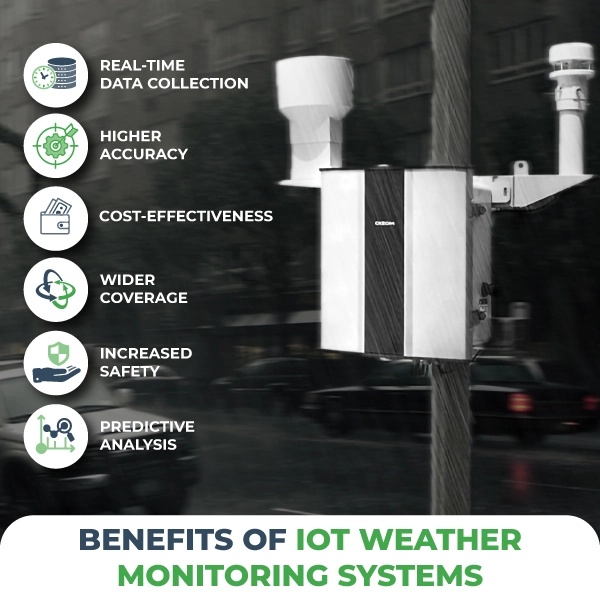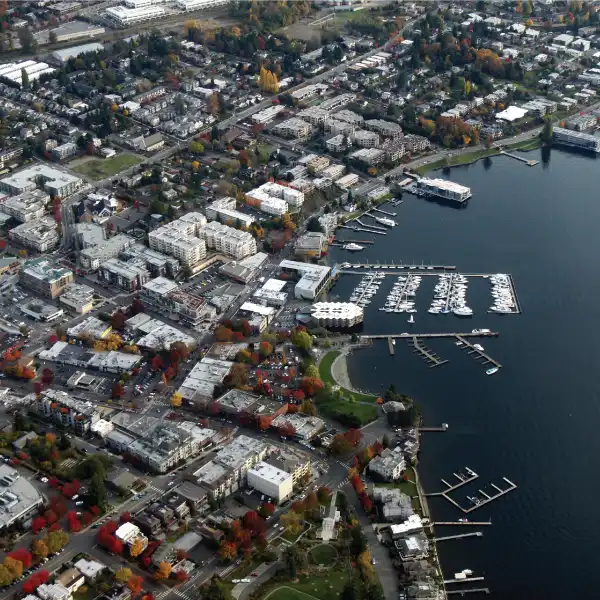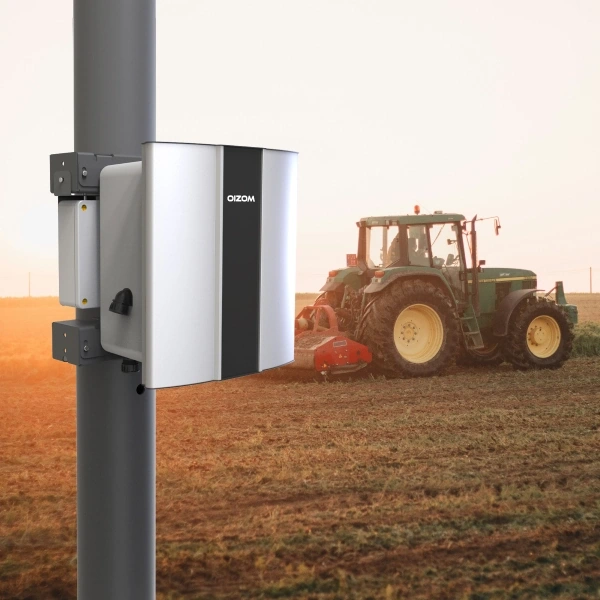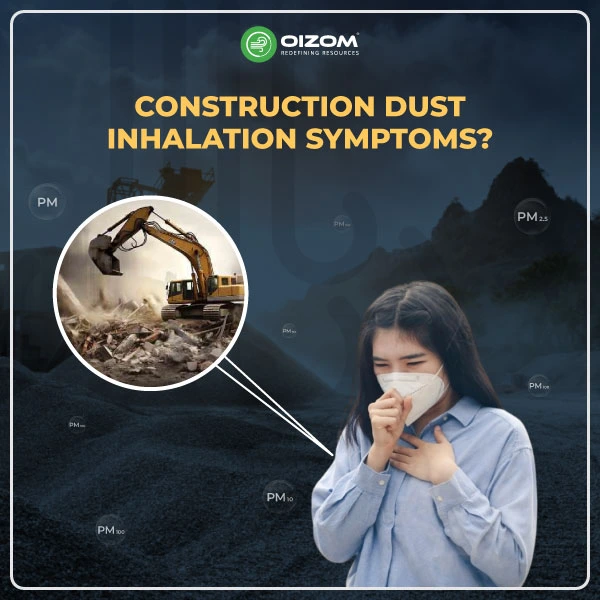Key Takeaway Points
- Real-Time Data: IoT weather monitoring systems provide accurate, up-to-date weather information to help businesses plan and respond quickly to changing conditions.
- Enhanced Accuracy: IoT sensors offer precise weather data, improving forecasting accuracy for meteorologists and decision-makers in various industries.
- Cost-Effective: These systems are relatively low-cost compared to traditional methods, making them accessible for widespread use and reducing operational costs.
- Wide Coverage: IoT devices can be deployed in diverse environments, from urban areas to extreme locations like volcanoes and rainforests, ensuring comprehensive monitoring.
- Increased Safety: Real-time weather data and early warning systems help prevent accidents and protect lives by providing timely alerts for severe weather events.
- Optimized Resource Allocation: IoT systems improve efficiency in agriculture, transportation, and other sectors by providing detailed weather insights for better resource management.
- Data-Driven Decisions: Businesses can make informed choices about operations, disaster preparedness, and resource distribution based on accurate weather data.
- Improved Agriculture: Farmers benefit from accurate weather forecasts, which enhance crop management, irrigation scheduling, and overall yield and quality.
- Environmental Monitoring: IoT weather stations track environmental changes and pollution levels, helping authorities implement targeted mitigation strategies.
- Climate Change Insights: Continuous data collection improves the accuracy of weather forecasts and climate change projections, aiding long-term planning and sustainability efforts.
What are the benefits of IoT Weather Monitoring Systems? Changing How We Monitor Weather.
Imagine waking up in the morning and knowing exactly what to wear, how to plan your day, and even how to protect your crops. Imagine a world where the weather is no longer an unpredictable force that catches us off guard, all thanks to real-time weather insights delivered straight to your smartphone. That’s the magic of weather monitoring systems in the Internet of Things (IoT). This reality is already here, owing to IoT-based weather monitoring systems. How do they work, which industries do they serve, and what benefits do they offer? Without weather monitoring, many countries face severe economic and environmental damage.
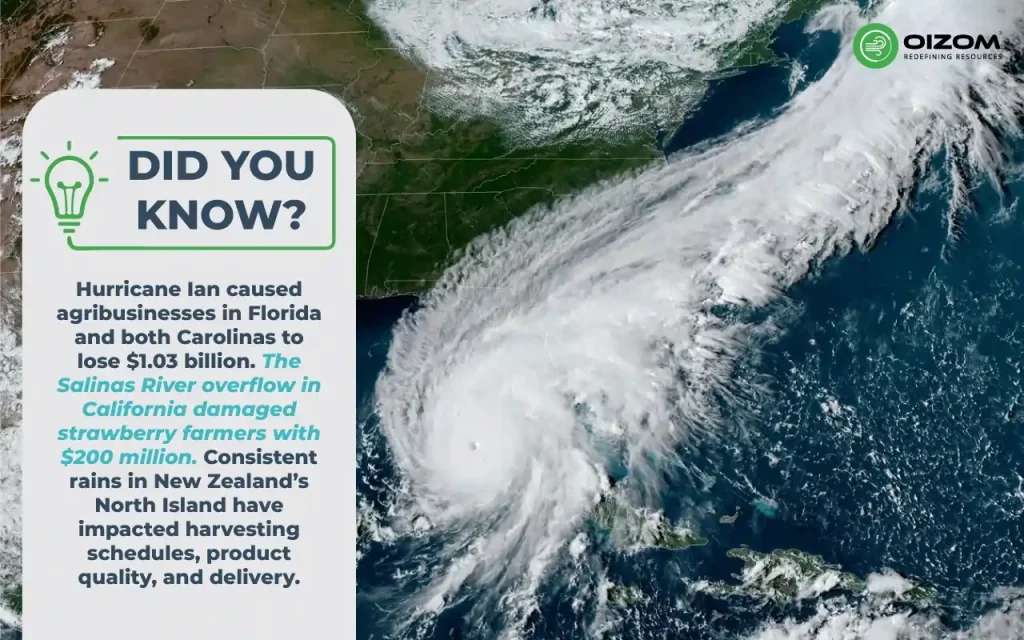
So, let’s dive into how these innovative weather monitoring systems change how we interact with the environment. They’re making our lives easier and more informed. In this article, we’ll look at the benefits of weather-monitoring IoT devices. These smart-systems help authorities and individuals prepare better mitigation plans, reducing the impact of weather-related risks.
Benefits of Weather Monitoring System Using IoT
The objective of weather monitoring is to use advanced technologies to offer accurate, real-time data. In a world where weather unpredictability can significantly impact various sectors, having a reliable weather monitoring system is not just beneficial; it’s essential. These smart systems gather and analyze weather data from multiple sensors, providing accurate and timely information to enhance daily life and business operations.
Weather monitoring systems have improved, thanks to the Internet of Things, functioning with more accuracy, consistency, and speed. That’s all very well, but what benefits can businesses get from this technology?
The principle advantages are as follows:
- Real-time data collection
- Higher accuracy
- Cost-effectiveness
- Wider coverage
- Increased safety
- Predictive analysis
Let me tell you about one of the best benefits of IoT weather monitoring:
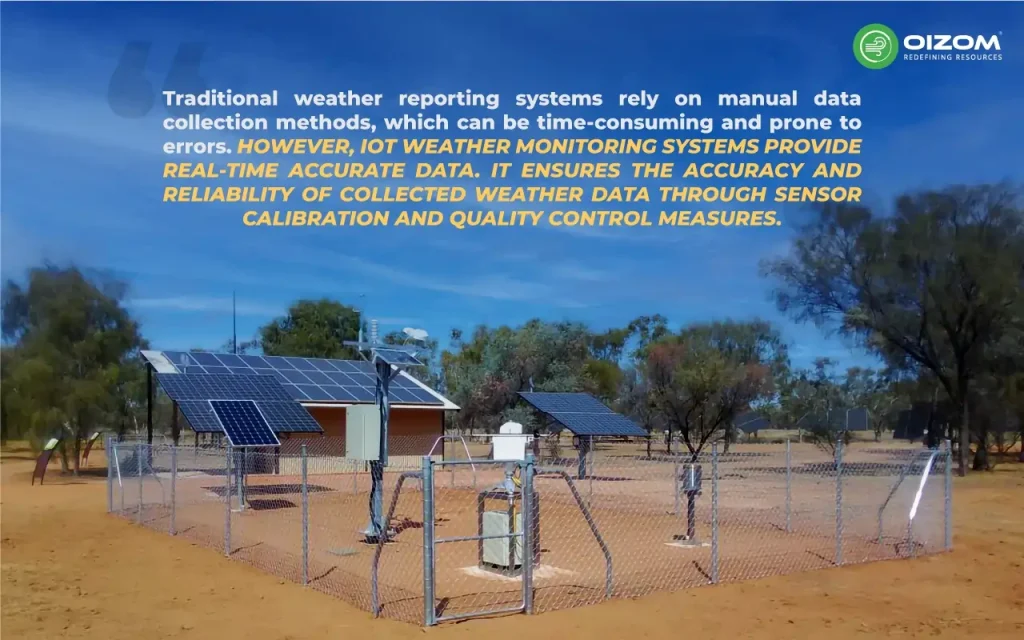
Real-time data and accuracy
These systems offer current meteorological data, which is essential for accurate forecasting and decision-making. Real-time weather monitoring makes it possible to react quickly to shifting weather patterns, improving readiness and lowering the risks related to unforeseen weather disasters. Meteorologists, agricultural planners, and disaster response teams depend on this real-time data to ensure they have the most recent information possible when making choices.
Instant access to weather conditions
The ability to instantly obtain weather conditions is revolutionary. Information was not shared as quickly in the past since traditional weather stations frequently relied on periodic data collection. IoT sensors, however, can collect data quickly, providing real-time information on critical elements like temperature, humidity, wind speed, and precipitation. Applications ranging from managing critical infrastructure to receiving personal weather updates benefit significantly from these IoT weather monitoring devices.
Improved forecasting accuracy
Meteorologists can predict their forecasts much more accurately by using large amounts of up-to-date weather data in complex models. This is crucial for extreme weather events like hurricanes, tornadoes, and floods because early warnings can minimize damage and save lives. Additionally, industries such as energy, aviation, and agriculture rely on precise forecasts to improve their operations and make better decisions.
Data-driven decision making
- Whether a farmer decides when to irrigate crops, an airline routes flights to avoid turbulence, or a city plans an emergency response, having access to accurate and timely weather information is paramount.
- For farmers, accurate weather forecasts mean better crop management and irrigation scheduling, leading to higher yields and resource conservation. For city planners, it means improved disaster preparedness and response, minimizing damage from extreme weather events. For everyone, it helps stay ahead of unexpected weather changes, ensuring safety and convenience.
- Even if they haven’t experienced a disaster, anyone in agribusiness knows that climate change is a serious concern. Decreased yields, higher resource use, and increased costs affect everyone. While there’s no single solution, technology-powered weather monitoring systems can help minimize weather-related risks.
Cost-efficiency
IoT devices are relatively low-cost compared to traditional weather monitoring equipment. This makes it easier for organizations to deploy multiple sensors in different locations for comprehensive weather monitoring.
Planning and buying a weather station requires consideration of costs, just like making other decisions. Compact weather stations are typically less expensive to buy completely when comparing accurate data. A further benefit is that they have a very small footprint and are simple to place onto a pole. On the other hand, typical weather stations will require a larger amount of land, which means that the cost of purchasing, renting, or borrowing this land will increase due to its larger footprint.
Reduced operational costs
The main advantage is lower operating costs. Traditional weather monitoring requires a lot of manual data collection and infrastructure maintenance. In contrast, IoT sensors need less human involvement. By automating data collection and delivery, organizations can significantly reduce costs. Real-time data can also optimize resource distribution, such as water and energy use in agriculture and buildings. For example, smart thermostats can adjust heating and cooling based on current weather conditions to save energy.
Optimized resource allocation
IoT weather monitoring systems are very good at allocating resources as efficiently as possible by using insights from data. How to do it is as follows:
- Effective Sensor Location: IoT systems can identify the best sites for sensor deployment by examining past weather data and trends. This ensures that crucial data points are recorded without overloading areas with unnecessary sensors.
- Dynamic Power Management: IoT devices depend on finite power sources, particularly those that are located in remote areas. Power usage can be optimized with weather data. For example, sensors can save battery life by lowering the frequency of data transmission during periods of stable weather.
Early warning systems for potential damage
Additionally, IoT can be used to set up early warning systems for extreme weather occurrences like floods, tornadoes, and hurricanes. This enables people and authorities to take the appropriate safety measures and lessen any harm.
For farmers or agricultural activities, IoT-based weather-tracking systems can provide early alerts for dangerous conditions such as severe heat, frost, hail, heavy rain, and strong winds. This enables farmers to safeguard their crops proactively.
Improved safety
IoT-based automated weather stations benefit industries like transportation and construction that are vulnerable to weather-related hazards. These companies can schedule their operations more safely and with fewer mishaps and interruptions.
Efficient disaster management
Early warning systems are one of the main ways the IoT revolutionizes disaster preparedness. Connected sensors thoughtfully positioned around cities monitor air quality, weather patterns, and seismic activity. These sensors set off automated notifications during irregularities, giving authorities and locals vital early warnings. By being proactive, we may prepare ahead of time, evacuate, and quickly mobilize resources to lessen the impact of future disasters.
Protection of life and property
- By forecasting severe weather and reducing environmental disasters, weather monitoring systems improve safety. When communities and authorities receive early warnings of upcoming storms, hurricanes, floods, and other dangerous weather events, they can take preventative action to save lives and property.
- For instance, traffic management authorities and drivers can be made aware of hazardous road conditions via highway weather monitoring systems, which lowers the likelihood of accidents. As an Automatic Weather Station (AWS), Weathercom is not just an instrument but a lifeline for those needing real-time, hyper-local weather parameters. With Weathercom’s wide array of measurements, from solar radiation to humidity, timely decisions aren’t just possible; they have become the norm.
- In the same way, methods for monitoring the weather that is favorable to wildfires can identify situations that allow for early intervention and lessen the impact of such disasters.
Enhanced agriculture
In agriculture, weather monitoring systems provide accurate weather data that help farmers make informed decisions about irrigation, planting, and harvesting. Agribusinesses can also use this technology to collect data about the physical, chemical, and biological aspects of soil. Ongoing observation can enable better irrigation, fertilization, and crop selection.
Precision farming based on weather data
Weather forecasts help farmers make informed choices about crop selection, watering schedules, and pest management. With real-time monitoring, farmers may receive precise data on soil moisture levels, guaranteeing the best possible crop output.
Consider an agricultural expert, reliant on accurate rain predictions, or a coastal town administrator monitoring wind speeds during a brewing storm. Strategizing mitigation action would be so handy for them, saving them from a significant loss.
Optimized irrigation and crop management
By installing Weather monitoring sensors across their farms, farmers can obtain vital meteorological data, including temperature, humidity, rainfall, wind speed, and soil moisture. This information is sent to a central platform to be examined and analyzed to determine the particular circumstances of every field. With this information, farmers can set up accurate irrigation schedules that guarantee crops get just the right amount of water without wasting it or overwatering them.
Increased crop yield and quality
IoT weather monitoring systems are instrumental in boosting both crop yield and quality. By providing real-time data on crucial factors like temperature, humidity, rainfall, and soil moisture, farmers can make precise, data-driven decisions.
Optimized irrigation accurate soil moisture data prevents overwatering or underwatering, maximizing water efficiency and promoting healthy plant growth.
Early disease detection: Timely information on weather conditions helps identify ideal environments for pests and diseases, enabling early intervention and preventing crop loss.
Environmental monitoring:
No matter how big or little, an IoT-based weather reporting system keeps track of all environmental changes. It implies that you are always aware of the situation and can plan ahead for severe weather.
Tracking climate change patterns
An Internet of Things (IoT)-based weather monitoring system mechanism can increase the precision of weather forecasts and climate projections by gathering vast amounts of meteorological data.
Identifying pollution levels
Particulate matter, chemical contaminants, heavy metals, greenhouse gases, and particulate matter can all be monitored with IoT sensors. Authorities are able to locate pollution hotspots, identify the origins of pollutants, and carry out focused mitigation strategies thanks to real-time data on pollution levels.
Conclusion
If you’re tired of unexpected weather messing up your business plans, consider using an IoT-based weather monitoring system. This solution provides real-time weather data and accurate forecasts, helping you keep things running smoothly and avoid disruptions.
In extreme environments like volcanoes or rainforests, IoT weather stations constantly monitor and report conditions, giving crucial data for safety and research. With the climate becoming more unpredictable, advanced real-time monitoring systems are more important than ever.
Today, weather monitoring systems are essential tools that offer valuable information for various uses. They have many benefits, from improving consumer goods and agriculture to enhancing safety in the automotive and industrial sectors. These systems are getting better all the time, using the latest technology like IoT to provide more accurate and detailed data to meet the growing needs of many businesses.
FAQs
- Improved Planning: Accurate weather forecasts help businesses plan operations more effectively, reducing disruptions.
- Safety: Timely weather updates can prevent accidents and protect people in extreme weather conditions.
- Cost Savings: Anticipating weather changes can help avoid costly damage to property and equipment.
- Better Predictions: Analyzing weather data leads to more accurate and reliable forecasts.
- Trend Identification: Data analysis helps identify long-term weather patterns and trends.
- Informed Decisions: Businesses can make better decisions based on comprehensive weather data analysis.
- Real-Time Data: IoT weather stations provide continuous, up-to-date weather information.
- Remote Monitoring: Monitor weather conditions from anywhere, improving efficiency and response times.
- Enhanced Accuracy: IoT technology improves the precision of weather data collection and forecasting.

